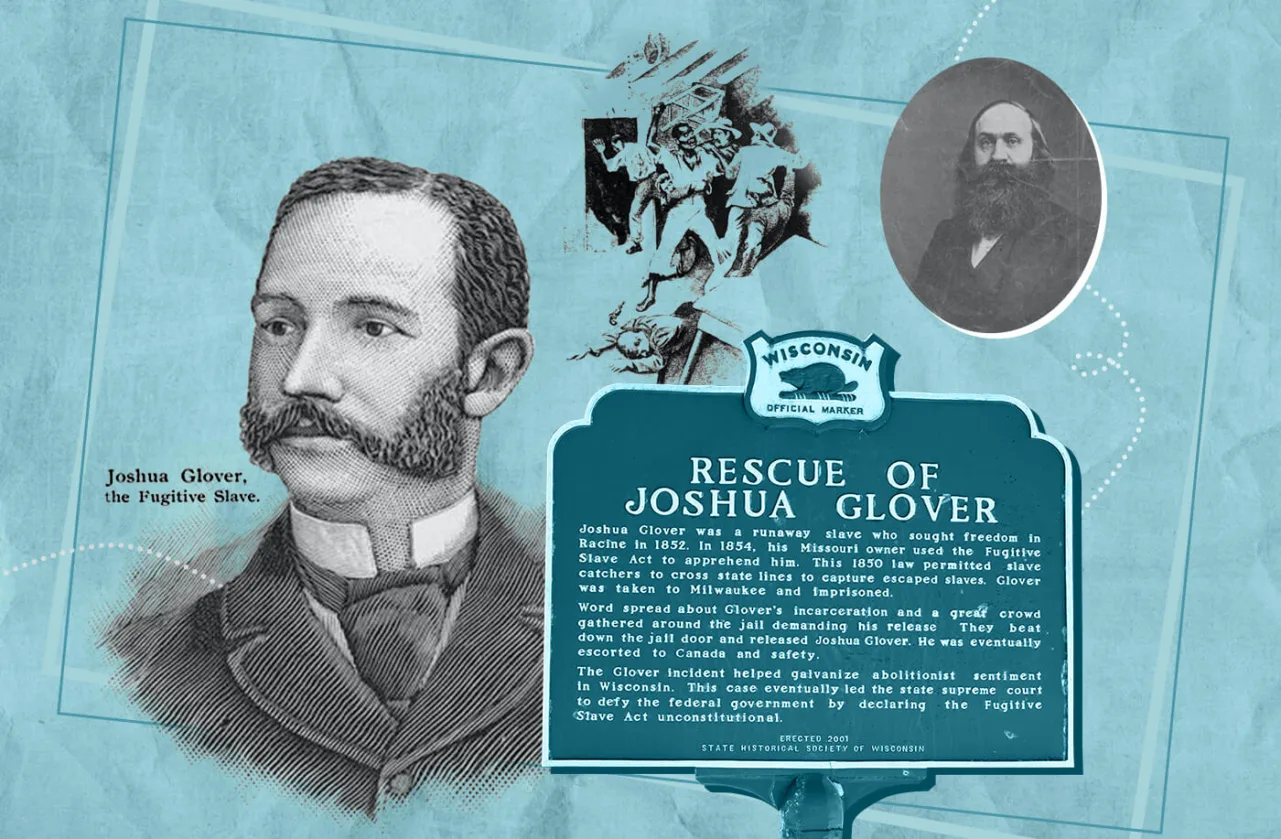
#image_title
#image_title
“It’s a white hero rescuing Black people, and I think that that serves a very particular narrative.”
It was 1852, and Joshua Glover was finally a free man.
Glover, an enslaved Black man, fled his owner in St. Louis, Missouri. He made the long journey to Wisconsin, a state where chattel slavery was illegal, and settled down in Racine.
The free life didn’t last. In March of 1854, he was captured by slave catchers under the Fugitive Slave Act. He was jailed in downtown Milwaukee, destined to be returned to St. Louis.
But before the slave catchers could bring him back, a group of white abolitionists led by abolitionist newspaper editor and politician Sherman Booth paraded from town to town gathering supporters to go rescue Glover.
“Much like Paul Revere—the British are coming, the British are coming—Joshua Glover is in jail on our [abolitionists’] turf, and we must make every effort to rescind this, to break him out of jail,” said Clayborn Benson, executive director of the Wisconsin Black Historical Society, explaining how Booth gathered support.
A mass of hundreds from around southeastern Wisconsin stormed the jail and broke Glover out. Glover hid around the state for 40 days before he eventually got a boat to Canada, according to the Wisconsin Historical Society. He started a family and lived there the rest of his life.
The rescue, which at the time was a massive national news story, is today well-known in southeastern Wisconsin—especially Milwaukee and Racine, the cities from which most of the abolitionists who helped Glover escape originated. The white abolitionists are often lionized; the jailbreak is frequently held up as a sign of Wisconsin’s progressive roots.
But the tale—while important to state and national history—is more complicated than that, historians told UpNorthNews.
“It’s a white hero rescuing Black people, and I think that that serves a very particular narrative,” said Christy Clark-Pujara, associate professor of history and Afro-American studies at UW-Madison.
That narrative hides a more difficult past. Frequently overlooked in Glover’s story is the fact that there were also Black abolitionists in the crowd that rescued him, Benson and Clark-Pujara said. The story is also twisted to make it seem like Wisconsinites fully accepted Black people in the 1850s, they said. In truth, it was the opposite.
“Wisconsin is this place where if you were a fugitive slave passing through, you could reasonably expect to find help,” Clark-Pujara said. “But if you wanted to live out your life in Wisconsin, you were going to do it on the political margins and on the social margins.”
The abolitionists’ fervor over Glover’s arrest was not primarily because of any anti-racist beliefs, Benson said.
“It’s not the case at all,” Benson said. “The real reason why these abolitionists broke him out of jail was because of their own political beliefs, their own religious beliefs, their own economic beliefs. And some of their ancestors, too, suffered enslavement throughout the years.”
Further puffery surrounding the story is the claim that Booth’s mob was 5,000 strong—a statistic seen in newspapers and even the state’s official tourism bureau, Travel Wisconsin. The number is made even more staggering by the fact that Milwaukee had just 20,000 residents as of the 1850 Census, meaning that a quarter of the city’s population would have been present.
The actual number was closer to 500, Benson said, explaining that the claim of a 5,000-person crowd only materialized years later in books. In a speech given 43 years after the Glover rescue, Booth himself only claimed “large numbers” of people in the crowd.
The exaggerated claim serves the false narrative that the state was more progressive than it truly was.
“Were there white people throughout the upper Midwest that helped enslaved people get to Canada? Absolutely,” Clark-Pujara said. “As many as people claim? No.”
The Glover story is “absolutely important,” said Eugene Tesdahl, an associate history professor at UW-Platteville. But, focusing too intensely on it, he said, erases the plight of Black people in Wisconsin throughout its history.
As the Milwaukee-based America’s Black Holocaust Museum noted in an essay, there is a Wisconsin Historical Society marker at the site of Glover’s rescue and a mural depicting his escape in an interstate underpass. At the time of the essay, there was no such memorial to be found for George Marshall Clark, the only Black man whose lynching is documented in Wisconsin’s history.
Clark was jailed in 1861 in what is now Cathedral Square in Milwaukee, according to the Milwaukee Independent. Like in Glover’s case, a large group of people came to the jail to break Clark out; but Clark, who was imprisoned over a fight with two white men, wasn’t helped to Canada. He was lynched instead.
The lynching had a “chilling effect” on Black Milwaukeeans, causing some to leave town, according to the Independent. The Milwaukee County Historical Society designated the lynching site a historical landmark in 2018.
“Public awareness of the incident is a step along the path of healing social trauma that continues to haunt residents of the Metropolitan area,” the Milwaukee Independent wrote in 2018. However, incomplete stories like the white abolitionists coming to the rescue of Glover remain the most prevalent.
“It can be misleading,” Tesdahl said. “Or some people might say, ‘Well, we talked about Joshua Glover, so we’re good.’
Politics

New Biden rule protects privacy of women seeking abortions
Under the new rules, state officials and law enforcement cannot obtain medical records related to lawful reproductive health care with the goal of...

Biden marks Earth Day by announcing $7 billion in solar grants
The Biden administration on Monday announced the recipients of its Solar For All Program, a $7 billion climate program that aims to lower energy...
Local News

Stop and smell these native Wisconsin flowers this Earth Day
Spring has sprung — and here in Wisconsin, the signs are everywhere! From warmer weather and longer days to birds returning to your backyard trees....

Your guide to the 2024 Blue Ox Music Festival in Eau Claire
Eau Claire and art go hand in hand. The city is home to a multitude of sculptures, murals, and music events — including several annual showcases,...



